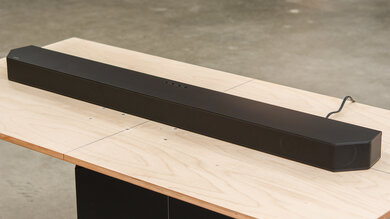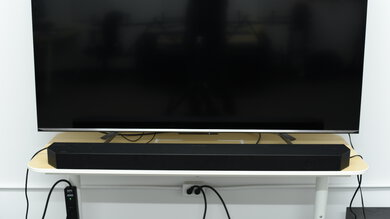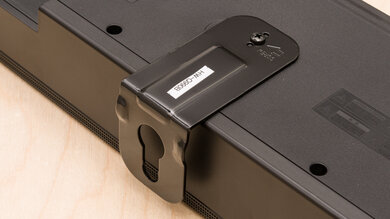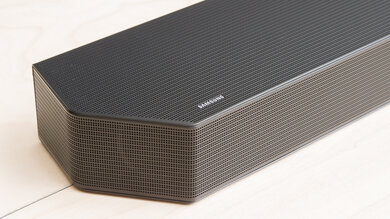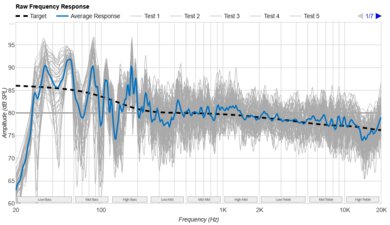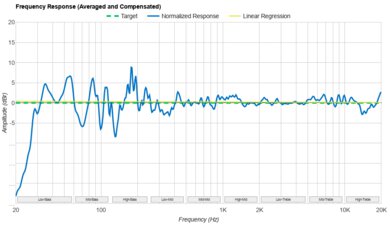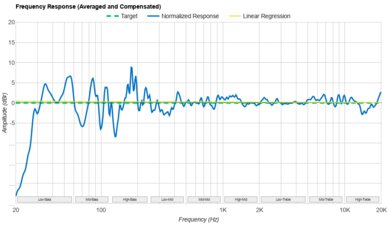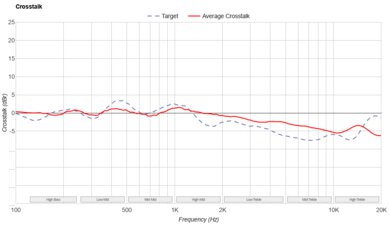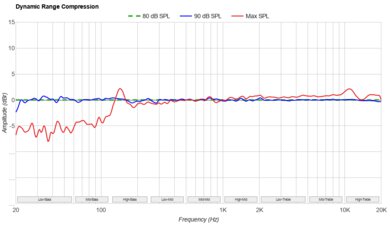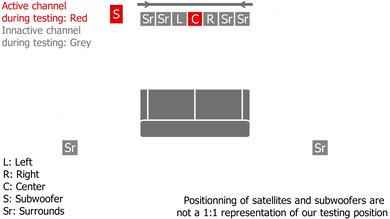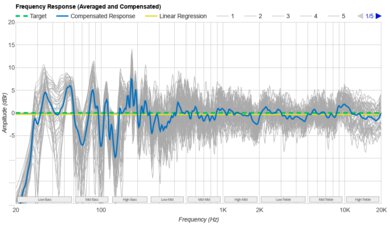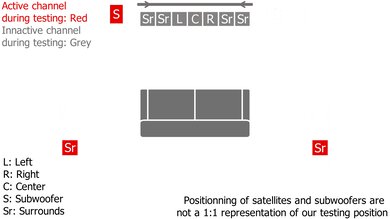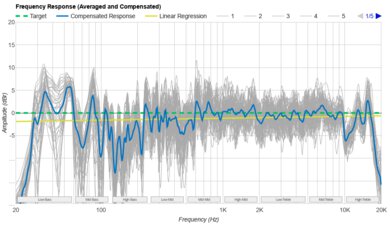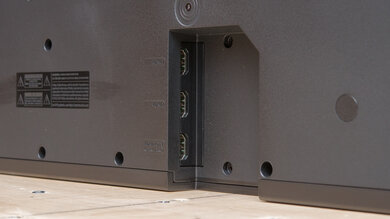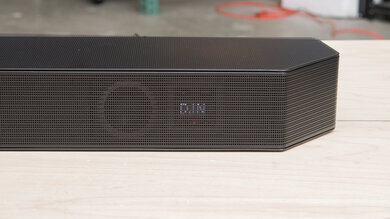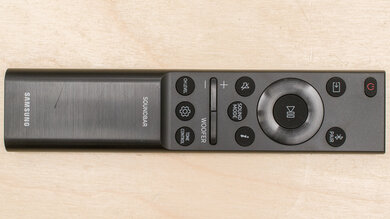The Bose Solo Soundbar Series II is a budget-friendly 2.0 setup released in 2021. It's a newer alternative to the Bose Solo 5 with a similar offering of features. Its small, compact design is ideal if you don't have a lot of space in your setup. While it's a solid upgrade over your existing TV speakers, it lacks lots of features compared with Bose's pricier options, so you don't find many sound enhancement tools to customize its sound or HDMI support to control the bar with your TV remote. It pales compared to flashy Dolby Atmos bars with many features, but it's a fine choice if you want something simple.
Our Verdict
The Bose Solo Soundbar Series II is middling for mixed usage. It's a simple 2.0 bar best suited for stereo content, including most music and TV shows. Its neutral sound means that most voices and lead instruments reproduce with clarity. However, like most small standalone bars, there's a noticeable lack of low-bass, so you don't feel the rumble in bass-heavy music or movies. Its 2.0 setup doesn't allow you to take advantage of more immersive audio formats, either. You have a few tools, like a bass adjustment feature, to customize its sound a little, but otherwise, this simple bar is quite limited in its offerings.
- Bass adjustment feature.
- Bluetooth-compatible.
- Few customization tools.
- No Dolby Atmos support.
The Bose Solo Soundbar Series II is fair for dialogue-heavy TV shows and podcasts. Though it lacks a discrete center channel, you won't have issues following the conversation in your TV shows. There's even a dialogue enhancement mode to improve vocal clarity, which is a nice touch. Unfortunately, sound enhancement features are otherwise limited, so you don't have an auto-volume feature to balance the volume between different programs and commercials, for example.
- Bluetooth-compatible.
- Dialogue enhancement tool.
- Few customization tools.
- No Wi-Fi, Chromecast, or Apple AirPlay support.
The Bose Solo Soundbar II is fair for music. Out-of-the-box, it reproduces vocals and lead instruments with clarity and accuracy, making it suitable for listening to many genres. However, like most small bars, it can't reproduce the deep rumble in the low-bass found with bass-centric genres like EDM and hip-hop. You won't find many sound customization tools besides its bass adjustment feature.
- Bass adjustment feature.
- Bluetooth-compatible.
- Lacks low-bass.
- Few customization tools.
The Bose Solo Soundbar Series II is disappointing for movies. It's a 2.0 bar, so you can't take advantage of more immersive audio formats found on most streaming platforms and Blu-rays. For example, there's no Dolby Atmos support. While it can playback 5.1 Dolby Digital content, it has to downmix it into stereo to play it, which doesn't sound as immersive. You don't feel the rumble in the bass during action-packed scenes, either.
- Bass adjustment feature.
- Dialogue enhancement tool.
- Lacks low-bass.
- No Dolby Atmos support.
- No discrete surrounds.
Changelog
- Updated Jan 29, 2024: Updated the text in the Stereo Dynamics and Audio Latency: Optical boxes per test bench 1.3 updates.
- Updated Jan 29, 2024: We've converted this review to Test Bench Update 1.3. If applicable, we've retested stereo sound based on the manufacturer's recommendations. Additionally, we've expanded our audio latency tests to the following boxes: Audio Latency: ARC, Audio Latency: HDMI In, and Audio Latency: Optical. You can see the full changelog here.
- Updated Jul 19, 2023: Updated text for clarity. No change in test results.
- Updated Jun 02, 2023: Converted to Test Bench 1.2. Updated the results for audio format support via ARC/eARC, HDMI In, and Optical. Added Video Passthrough to TV results as well.
Check Price
Differences Between Sizes And Variants
This soundbar is available in 'Black'. You can see the label for the model we tested here.
If you come across another version of this soundbar, let us know in the forums, and we'll update our review.
Popular Soundbar Comparisons
The Bose Solo Soundbar Series II is very similar to the 2019 Bose Solo 5. Both are 2.0 bars with limited features designed to enhance stereo content, which includes most music and TV shows. Their sound is quite similar, and while voices and lead instruments are clear, you miss out on the rumbling low-bass found in bass-heavy music and movies. It's a solid upgrade over your TV speakers at a budget-friendly price and a simple-to-use bar overall.
See also our recommendations for the best small soundbars, the best standalone soundbars, and the best Bose soundbars.
The Bose Solo Soundbar Series II and the Bose TV Speaker are similar 2.0 soundbars. The TV Speaker is better overall, having a couple of extra features. It's better built and has an HDMI ARC port, so it supports HDMI CEC to let you control the bar's basic features with your TV remote. Its stereo soundstage is better, too. These features may not be worth the value for some, so the Series II is a more affordable alternative.
The Sonos Beam is better than the Bose Solo Soundbar Series II. They're both small standalone soundbars with solid performances, but the Sonos has a better sound. It's better built, with a more neutral sound out of the box. Its soundstage is also much wider, so you feel more immersed in your audio. There's a discrete center channel to improve vocal clarity and more sound enhancement features to help you customize the sound.
The Bose Solo Soundbar Series II and the Bose Solo 5 are almost identical soundbars. Both have 2.0 setups, and their frequency responses are very similar, so you don't hear much difference in their sound. They offer the same sound enhancement features, too. Their design is slightly different, and the Series II's remote looks sleeker.
The Bose Smart Soundbar 300 is better than the Bose Solo Soundbar Series II. The 300 is a 3.0 setup, meaning it has a discrete center to improve vocal reproduction. It's better built, has more wireless playback options, and has an HDMI port for CEC support. Unlike the Solo, you can control its basic features with your TV remote as a result.
Test Results


